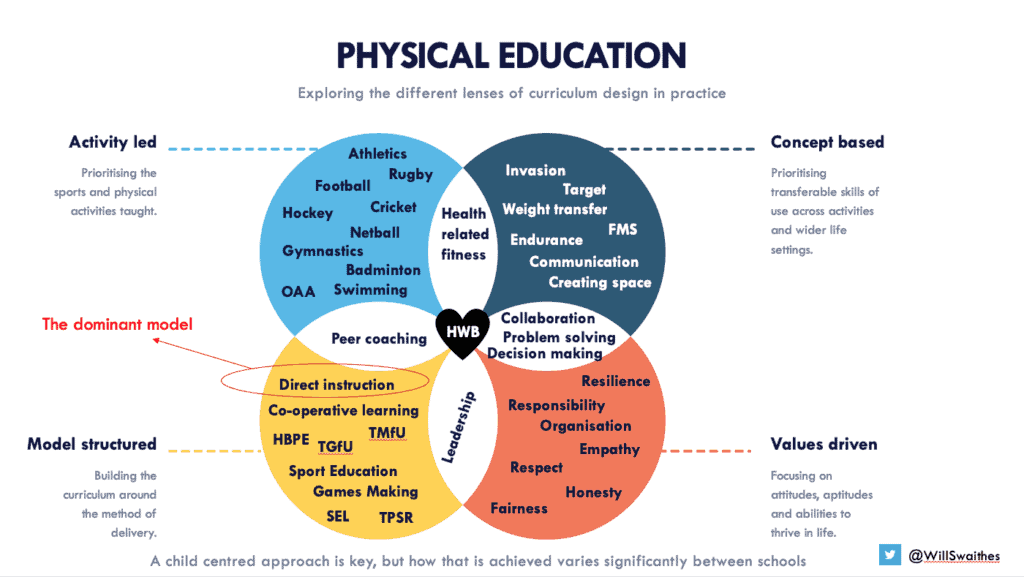
How do you nurture students to flourish in PE?
This blog seeks to get under the surface of how PE is taught and what areas of recent research I think every physical educator should be aware of to help our subject thrive. I will touch on Ofsted’s recent PE Research Review, Physical Literacy, the Meaningful PE framework and ideas from Moston’s Spectrum of Teaching Styles as well as Models-based Practice. I will even add a small sprinkling of Threshold Concepts.
Observing PE
I am extremely lucky. I get the chance to visit lots of schools every year. I revisit at least 30 of these schools from a range of different contexts multiple times a year. These range from inner-city Birmingham where many of my BCU trainees complete their school-based training to rural Leicestershire where my Loughborough University trainees are placed and right through to a whole range of independent schools from London to Nottingham where my University of Buckingham trainees are completing their PGCEs. On top of this, I am grateful for the opportunity to work with more experienced colleagues, Heads of Department and Head Teachers to support and challenge their PE provision via Faculty Reviews and bespoke CPD. I am also able to draw on what I hear via practitioner reflections built into our portfolio of PE Scholar courses and if you stay on top of our blog posts or follow us on twitter you will know we also get the chance to collaborate with expert researchers and Physical Education Teacher Educators (PETE) from around the world. Being involved in Sport England’s Secondary Teacher Training Programme as a consultant has also been an invaluable insight into provision. As a consequence, I feel I have a grasp of typical practice within our sector and I have a few headline observations:
- Firstly, even if we just focus on secondary schools in England, there is no such things as typical! Every school context is so different, the needs and motivations of every class are complex and ever changing.
- Consequently, it is only right that we equip our physical educators with the knowledge, with the skills, and with the experience to adapt their offer and style of delivery to suit the needs of the learners in front of them each day.
- It is only right that my role is about coaching and supporting practitioners to reflect accurately on what they did and what impact that had on that particular class in that lesson. My role is about helping individuals to do that more effectively and ‘on the fly’ so they are able to fine tune provision and better meet the needs of all learners.
- My role is to help practitioners find better ways to ensure PE stands for Positive Experiences for all children. My role is not about telling them what I would have done in that situation or trying to mould more teachers like me and I hope I manage to do that.
Ofsted’s PE Research Review
Hanna Miller recently led Ofsted’s Research Review into PE and from what I can see the suggested teaching in our subject should consider physical literacy, prioritise inclusion and be geared towards three pillars in terms of outcomes:
- Motor competence
- Knowledge of rules, strategies and tactics
- Healthy participation
It goes on to suggest physical educators should follow a simple three-part model to lesson delivery:
- Instruct
- Practice
- Feedback
As you would expect from the current narrative within Ofsted, much of it is framed around the importance of knowledge and strategies to increase retention of said knowledge. Read a more extensive summary of Ofsted’s PE Research Review here. It is important to avoid a reductionist approach to this 1,700 word review or to ignore valuable insight that is seemingly missing from it. If you haven’t yet read it, I recommend this reflective blog by Greg Dryer.
As promised, lets dig a bit further under the surface of the where, why, how and what of physical education with the help of a few visuals to simplify things.
PE – the big picture
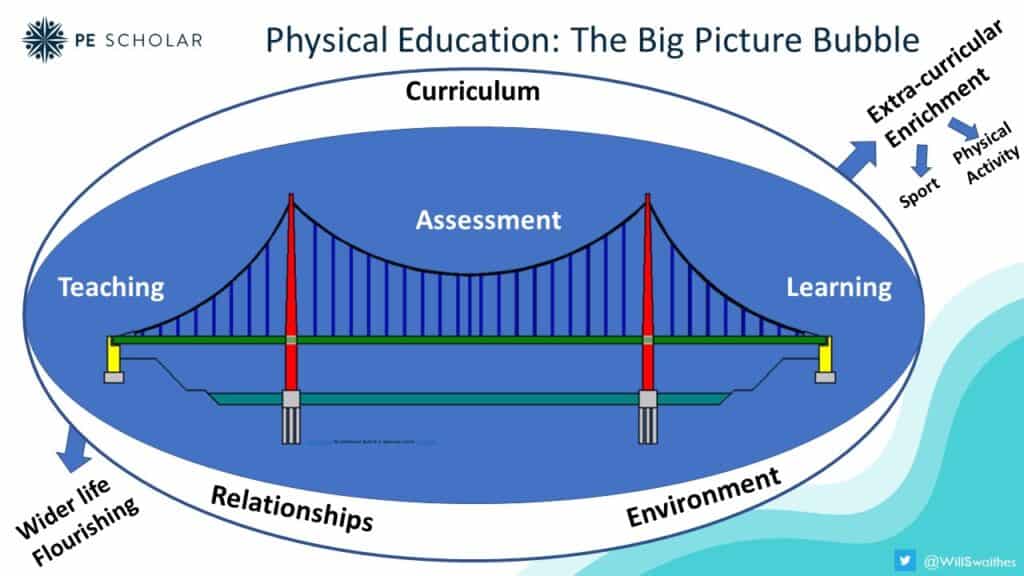
Dylan Wiliam often talks about assessment as being the essential bridge between teaching and learning but it continues to confuse, constrain and challenge the profession when it comes to getting it right. If that is true for you and your PE offer, why not check out our new ‘Assessment in PE’ course. Beyond this we need to carefully consider the relationships that are fostered in lessons, often through consistent routines and aided by a student-centred approach to learning in PE. Thankfully, strong rapport and positive relationships are something most PE teachers are pretty adept at developing. However, do you do this equally well with students that are not like you and do you or do you fall into the trap of spending 80% of your time with the 20% of students who need you least? In PE we have to contend with a whole host of different environments to teach in and this is an additional challenge compared with other curriculum subjects. In fact, most lessons include at least one change of environment from the changing rooms to the teaching space and of course the weather is a factor classroom practitioners don’t have to consider nearly as much.
This diagram also illustrates how the ‘curriculum’ bubble of PE is also closely connected to extra-curricular or enrichment opportunities for sport and physical activity as well as the responsibility towards health and well-being that contributes to wider life flourishing. This big picture needs to be understood but we must also remember that there are plenty of other contributors to sport, physical activity, health and well-being!
PE – our core purpose
Two frameworks that are becoming increasingly popular and significant when it comes to defining the ambition, purpose or intent of PE are physical literacy and meaningful PE.
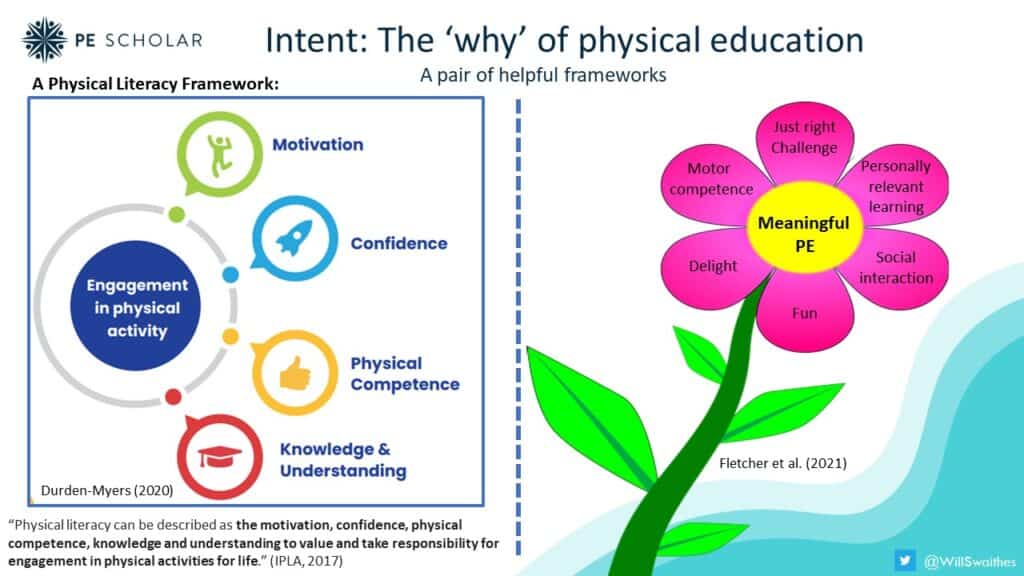
UNESCO provides a great video that helps frame the purpose of PE:
Our blog series exploring policy and practice from around the world shows some really innovative ideas and an increasing number of countries that are turning their attention towards:
- physical literacy;
- health;
- social justice
- prioritising play, broader concepts and a pivot away from traditional team sports
Physical Literacy
One thing is for certain, the gravitational pull towards physical literacy as a framework to consider PE is an extremely strong one. Liz recently presented on this to colleagues at DfE and Sport England have also commissioned a consensus project being led by Liverpool John Moores University that we are pleased to be a part of. Read more here and watch this space for future announcements.
If you have followed our work for a while you will be pretty comfortable with the IPLA (2017) definition whereby ‘Physical Literacy can be described as the motivation, confidence, physical competence, knowledge and understanding to value and take responsibility for engagement in physical activities for life.’
We would love to take you on a journey of discovery to some of the deeper layers of the physical literacy iceberg and this ‘Introducing Physical Literacy’ course is the best way to do just that.
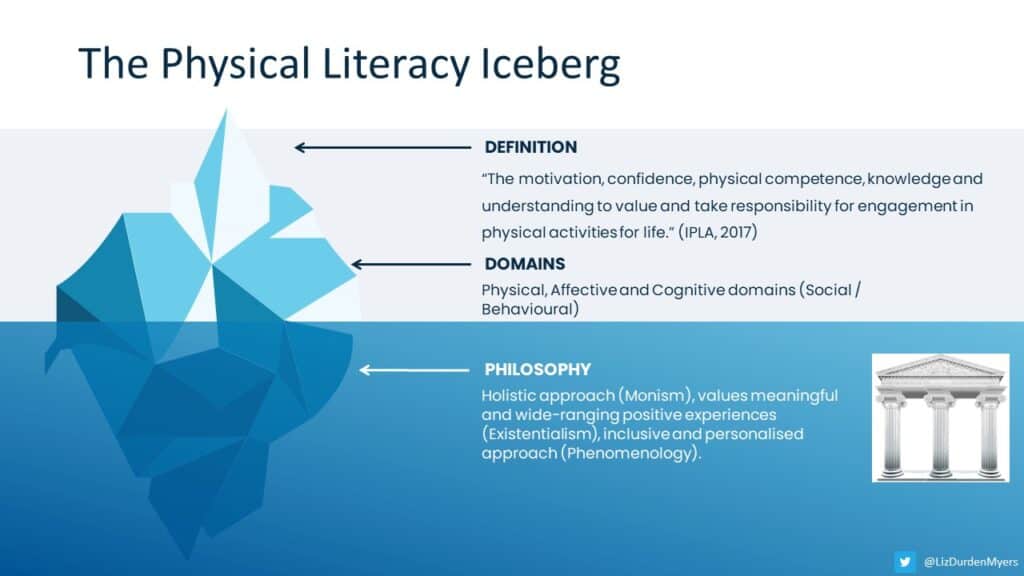
Read more about what Liz Durden-Myers, Nigel Green and Margaret Whitehead have proposed as seven key priorities for physical literacy informed practice here.
Meaningful PE
The six strands of Meaningful PE I have illustrated on the flower above are those that Tim Fletcher, Déirdre Ní Chróinín, Doug Gleddie and Steph Beni have been popularising and bringing to life
- motor competence
- social interaction
- just right challenge
- personally relevant learning
- fun
- delight
How well do you consider all of these when designing and sharing your curriculum intent with your students? Read more on the book recently published by Fletcher et al. here.
PE – how to deliver great lessons
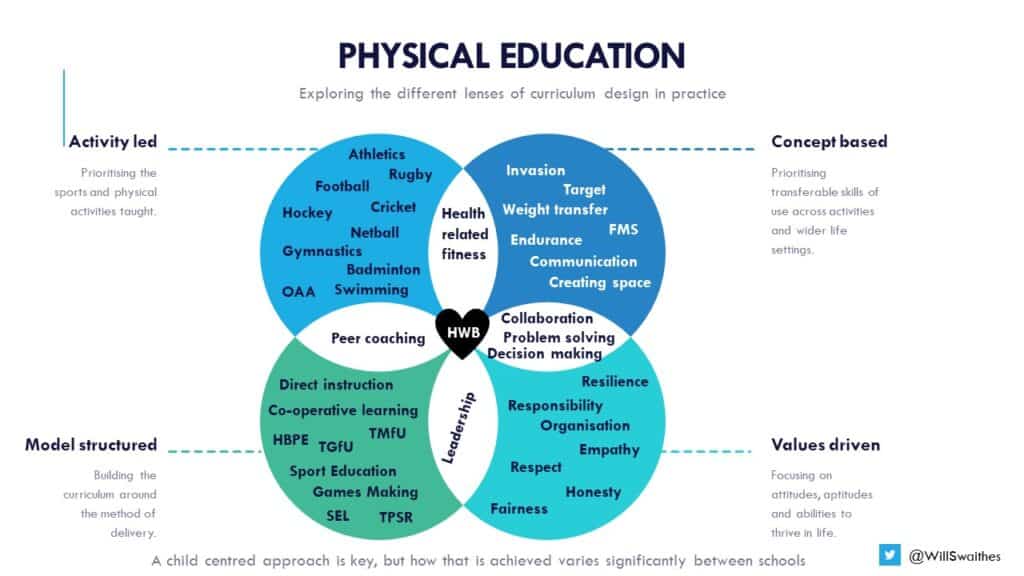
About two years ago I shared this simple infographic on Twitter and people continue to tell me that it helped challenge their thinking. We have heard a lot more about concept curricula since and certainly a great number of practitioners are thinking more carefully about prescribing a rich and varied diet of approaches to the delivery of PE rather than just sticking to skill-drill style direct instruction.

As mentioned earlier, at a superficial level Ofsted seem to favour that direct instruction approach of instruct, practice and feedback but maybe that is just my interpretation. I am certainly hopeful that inspectors will recognise and value more than just the hammer in the PE teacher toolkit and, from what I have heard from PE deep dives, that is the case. I would consider the language of Mosston & Ashworth’s Spectrum of Teaching Styles as quite old now but it is having quite a revival. Which of the A-K screwdriver tools do you regularly use in your practice? What about others in your department. And then we have a set of spanners, different models that I am still shocked to find physical educators not utilising to the extent they should. The following three should definitely be a part of your regular practice:
- Teaching Games for Understanding (TGfU) and other game-based approaches
- Sport Education
- Co-operative Learning
I would also highly recommend looking into the work of Mark Bowler and Paul Sammon on Health-Based Physical Education. Read more on the work of Ash Casey and David Kirk on Models-based Practice in this book review.
Threshold Concepts are explored in a recent book by Chambers et al. which is summarised in our book review here.
PE – what should be included in an inclusive and well sequenced curriculum?

PE needs to be much more than a basket of sports, much more than a facilities driven carousel of activities that students participate in for a half term and then re-visit (or not) in a years’ time.

These activities are merely the vehicles for learning and should be selected carefully to develop the attitudes, values, knowledge and skills that are succinctly articulated in OECD’s Learning Compass as essential to the 21st century learner:
Our role is to give a rich variety of Sport, Physical Activity and Movement (SPAM) but also enough depth to develop competence.
Most schools categorise activities in the following way and are heavy on the blue strand of invasion games. What about you?
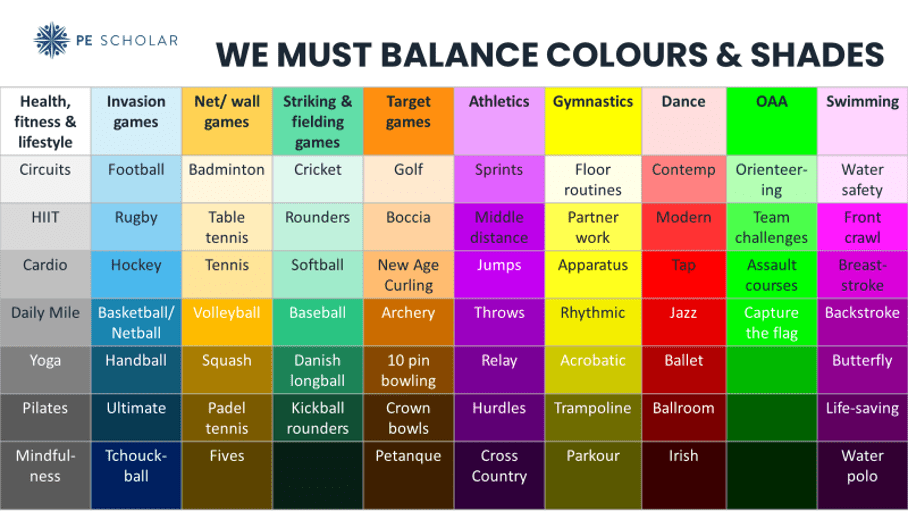
Perhaps we need a more revolutionary look at how activities are categorised to inspire an even better mix of activities that are tailored to the needs and motivations of today’s children. How about this for example?
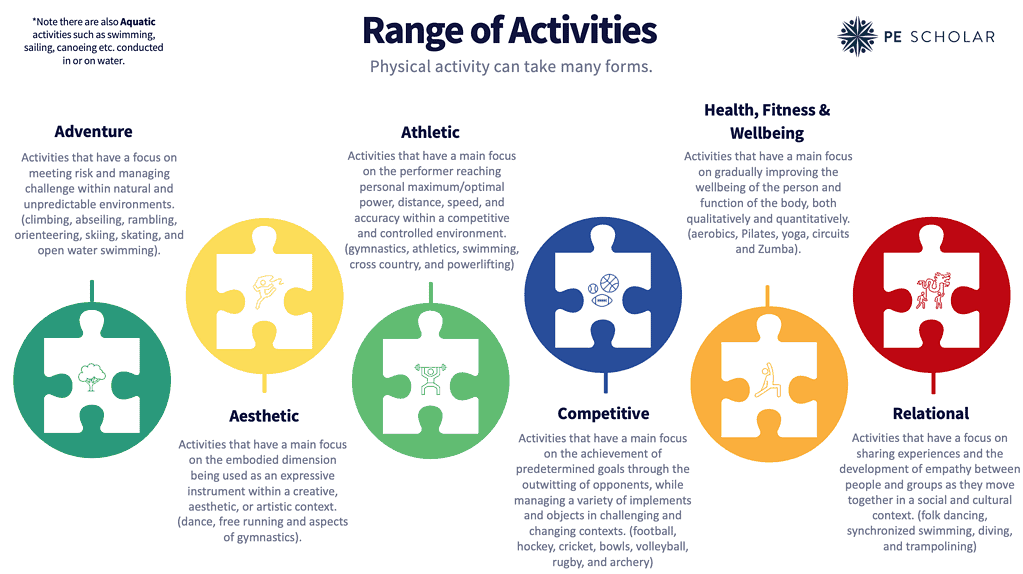
What Next?
When was the last time you took a day out to really see, feel and get under the surface of what goes on in PE in another context? Could you spark an opportunity to buddy up with another school and spend a day as a ‘fly on the wall’ to observe and support reflection on why they do what they do and how effective it seems to be? I guarantee it will be some of the best CPD you ever get and is well worth the time off timetable. We have helped a number of colleagues from our network to do just that and will continue to do so. If you would like help in identifying a buddy, please do get in touch.
Will Swaithes
August 2022


[…] I have a vision of utilising many of the models-based practices specified to specific classes as highlighted through a “PE Teacher Toolkit” in a blog by Swaithes (2022). […]